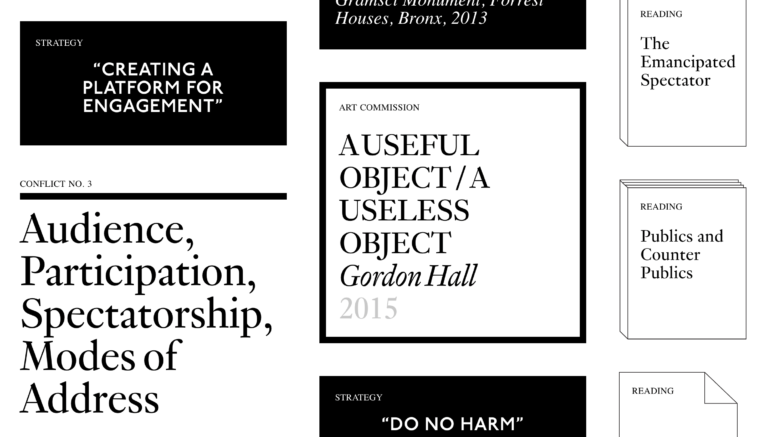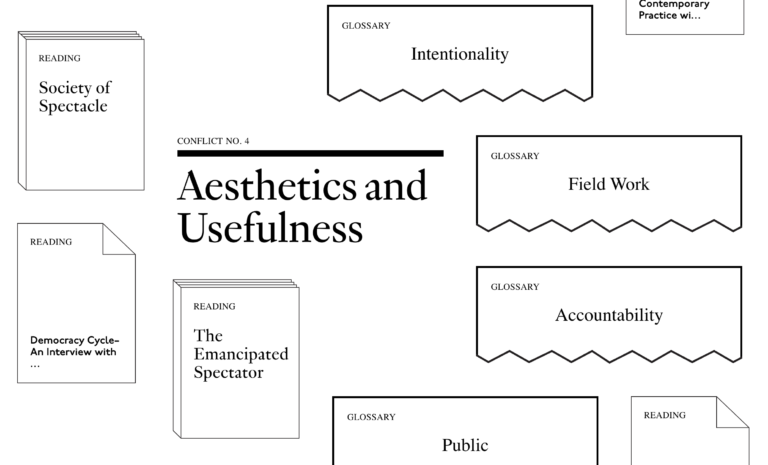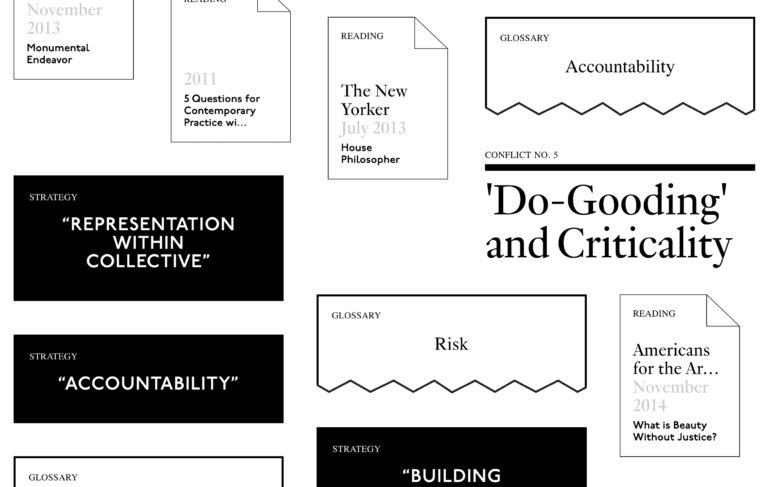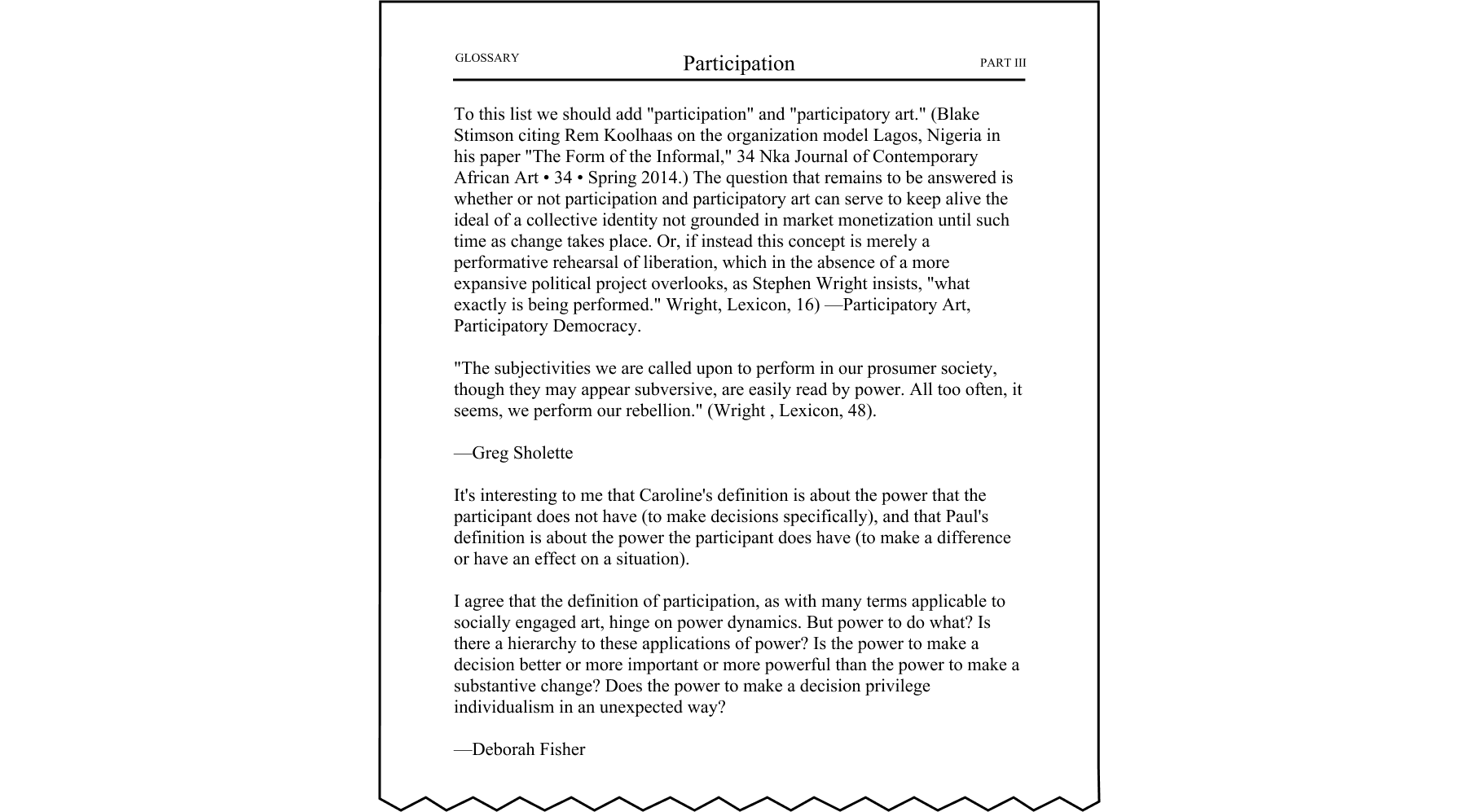
Event
CONFLICT NO. 2: Authorship, Collective and Other
Dec 10, 2014
When artworks are authored collectively, either by groups of artists working together or in a co-creative relationship with non-artists, it becomes important to understand the project in terms of its process over time, and to develop a different understanding of mastery, skill, credit, and social and cultural capital. How does this process of collaboration become visible and readable to an audience that is not actively participating in the work? Is it important that it does? What does masterful co-created work look like, and how is its aesthetic quality evaluated? Is it possible to share artistic identity, and the social and cultural capital that is associated with it?
These questions impact the temporal framework for looking at a socially engaged artwork as a non-participant, how the mastery and value of it is assessed, and the economic models that can be successfully applied to it. To perceive an artistic process, when must an external audience start looking, and how does this looking manifest itself? When a project initiated by artists is sustained long-term by a community of non-artists, does it remain an artwork? Does it change character? Does it achieve permanence? What economic models can be applied to collective creative practice? Is the active participation of non-artists in a project a declaration of its value? How does this value relate to other arbiters of value in contemporary art?
This episode looks at hybrid forms of often long-term collaborations where authorship is shared among groups of artists or participants or dispersed with and among audiences, with a particular focus on the temporal frame required for understanding works that are initiated by someone and expanded on – even completed – by someone else, and the value of shared authorship and artistic process.
ART CASE STUDY
Yams Collective
GLOSSARY
Harm
Ownership
Participation
Collaboration
Diaspora
STRATEGY
Representation within collective
CONFLICT NO. 2 | ART COMMISSION
Laura Grace Chipley
Rare Breed Art Collective
2015
Rare Breed is a collective of creative producers, activists and laborers who collaborate across generations to reinforce the role of mothers as a creative, innovative and political force.
In 2015 collective members initiated a series of multi-disciplinary creative projects to explore and re-imagine the culture of motherhood. Projects will included a consideration of the following questions: How do you learn to be a mother? What did you learn from your own mother? What have your children learned from you? How can a mother’s teaching practice effectively challenge systems of oppression or encourage social transformation? How can children’s destructive powers be harnessed for creativity? How can artistic collaborations between mothers and children transform or interrupt temporal and financial constraints and established patterns of domesticity?
Rare Breed Art Collective was commissioned by the Vera List Center for Art and Politics and A Blade of Grass in response to the second Art and Social Justice Working Group conflict – Authorship, Collective and Other.
– – –
LAURA GRACE CHIPLEY is an interdisciplinary artist based in New York City. Her projects include ‘Deep Black Sea’ – an experimental documentary series that chronicles the aftermath of oil spills around the world, and ‘The Newtown Creek Armada’ – an interactive boat pond created in a New York Superfund site. Her work has been featured by The New Yorker, The Wall Street Journal, Wired Magazine and Boing Boing. Laura is an Assistant Professor of Media and Communications at the State University of New York College at Old Westbury.
CONFLICT NO. 2 | READINGS
The Artist as Public Intellectual
Link
The Social Turn: Collaboration and its Discontents
Bishop, Claire. “The Social Turn: Collaboration and its Discontents.” Artificial Hells: Participatory Art and the Politics of Spectatorship. Verso, 2012.
Link
A critique of participatory art (in opposition or reaction to Grant Kester, Nicolas Bourriaud, Nato Thompson, Shannon Jackson). Through a historical and theoretical overview of 20th century social practice, Bishop ultimately argues for a set of criteria with which to judge the artistic value (as well as social/ethical value) of participatory art.
The Production of Social Space as Artwork Protocols of Community in the Work of Le Groupe Amos and Huit Facettes
Enwezor, Okwui. “The Production of Social Space as Artwork Protocols of Community in the Work of Le Groupe Amos and Huit Facettes.” In Collectivism After Modernism, Gregory Sholette and Blake Stimson, eds. Minneapolis: University of Minnesota Press
Link
Spanning the globe from Europe, Japan, and the United States to Africa, Cuba, and Mexico, Collectivism after Modernism explores the ways in which collectives function within cultural norms, social conventions, and corporate or state-sanctioned art. “To understand the various forms of postwar collectivism as historically determined phenomena and to articulate the possibilities for contemporary collectivist art production is the aim of Collectivism after Modernism. The essays assembled in this anthology argue that to make truly collective art means to reconsider the relation between art and public; examples from the Situationist International and Group Material to Paper Tiger Television and the Congolese collective Le Groupe Amos make the point. To construct an art of shared experience means to go beyond projecting what Blake Stimson and Gregory Sholette call the “imagined community”: a collective has to be more than an ideal, and more than communal craft; it has to be a truly social enterprise. Not only does it use unconventional forms and media to communicate the issues and experiences usually excluded from artistic representation, but it gives voice to a multiplicity of perspectives. At its best it relies on the participation of the audience to actively contribute to the work, carrying forth the dialogue it inspires.
Artists’ Collectives Focus on New York, 1975–2000
Moore, Alan W. “Artists’ Collectives Focus on New York, 1975–2000.” In Collectivism After Modernism, Gregory Sholette and Blake Stimson, eds. Minneapolis: University of Minnesota Press, 2006.
Link
The (Un)sitings of Community
Kwon, Miwon. “The (Un)sitings of Community.” One Place After Another: Site-Specific and Locational Identity. Cambridge and London: MIT Press, 2002.
Link
Site-specific art emerged in the late 1960s in reaction to the growing commodification of art and the prevailing ideals of art’s autonomy and universality. Throughout the 1970s and 1980s, as site-specific art intersected with land art, process art, performance art, conceptual art, installation art, institutional critique, community-based art, and public art, its creators insisted on the inseparability of the work and its context. In recent years, however, the presumption of unrepeatability and immobility encapsulated in Richard Serra’s famous dictum “to remove the work is to destroy the work” is being challenged by new models of site specificity and changes in institutional and market forces. One Place after Another offers a critical history of site-specific art since the late 1960s and a theoretical framework for examining the rhetoric of aesthetic vanguardism and political progressivism associated with its many permutations. Informed by urban theory, postmodernist criticism in art and architecture, and debates concerning identity politics and the public sphere, the book addresses the siting of art as more than an artistic problem. It examines site specificity as a complex cipher of the unstable relationship between location and identity in the era of late capitalism.
The Fluxus Performance Workbook
Friedman, Ken, Owen Smith, and Lauren Sawchyn, eds. The Fluxus Performance Workbook. Performance Research e-Publications, 2002.
Link
Fluxus was an iconic and informal group of international avant-garde artists working in a wide range of media that was active from the early 1960s to the late 1970s. Their activities included public concerts or festivals and the dissemination of innovatively designed anthologies and publications, including scores for electronic music, theatrical performances, ephemeral events, gestures and actions constituted from the individual’s everyday experience. Other types of work included the distribution of object editions, correspondence art and concrete poetry. This book is a collection of classic Fluxus scores.
Radical History Review
The Future of the Commons
Harvey, David. “The Future of the Commons.” Radical History Review, 109, Winter 2011, 101-107.
Link
Current thinking about the problem of how to manage common resources still dwells on arguments either in favor of or against enclosure, coming primarily from contemporary political and scholarly debate about the enclosure of the early modern agrarian English commons. Many considerations of the enclosure of the commons, however, have so far failed to account for a number of variables. For instance, the sensible management of common resources on a local scale may not function at all on a global one. Protecting forest biodiversity in areas populated by at-risk indigenous populations may call for trading off the protection of one commons for another. And commons also can be exclusionary, or can involve resources that are not scarce, such as intellectual property. In this essay, David Harvey argues that the real problem demanding our attention is private property, not the commons itself. The capitalist commons is being continuously enclosed, but it is also being continuously produced. To fulfill our common interests, we need to look to the powers of collective labor to address capitalism’s destruction of land and labor resources.
Third Text
The Delicate Essence of Artistic Collaboration
Wright, Stephen. “The Delicate Essence of Artistic Collaboration.” Third Text, Vol. 18, Issue 6, 2004, 533–545.
The Delicate Essence of Artistic Collaboration highlights the current state of artistic production and elaborates the challenges it faces. Issues around authorship, collaboration and process-oriented art works are put into relation to its economic context. Wright focuses on Argentina as a host for several case studies of artistic collaboration and civic engagement. He seeks to inquire the need for collaborative work in the first place, reconstructs it as the very condition for individuality and its inherent paradoxes.
Nka: Journal of Contemporary African Art
Black Collectivities: An Introduction
Copeland, Huey and Naomi Beckwith. “Black Collectivities: An Introduction.” Nka: Journal of Contemporary African Art, 34, Spring 2014, 4-7.
Link
“Black Collectivities” selectively reproduces and expands on the proceedings of a conference held in Chicago in May 2013 that brought together an international roster of artists, art historians, cultural critics, and curators invested in the histories and futures of collaborative practice in Africa and its diasporas. In this article, conference organizers Huey Copeland and Naomi Beckwith introduce the aesthetic, conceptual, and political stakes animating the conference and the issue emerging from it with an eye toward both critiquing mainstream artistic discourses around collectivity and articulating the centrality of black cultural practices to them.
Nka: Journal of Contemporary African Art
The Artist Corporation and the Collective
Gates, Theaster. “The Artist Corporation and the Collective.” Nka: Journal of Contemporary African Art, 34, Spring 2014, 74-79.
Link
From “Black Collectivities: A Conference,” held May 3–4, 2013, at Northwestern University’s Mary and Leigh Block Museum of Art, the Museum of Contemporary Art Chicago, and the University of Chicago’s Arts Incubator. After examining the vast structural responses to the need for collective organizing and synergistic effort, Gates has decided that the traditional corporation may offer us both relief and pleasure. His jest “I am fifteen corporations” is a declaration of radical business acumen (or foolishness) and a cry about the need for additional structures of inclusivity, including corporations. While examining the role of legal entities, Gates also posits the necessity for temporary and informal collectives, the gatherings that convene and dissolve around caring for places, things, and people. Referencing the archives housed at his Dorchester Projects, Gates discusses the collective in relationship to collections.
Contributions in Black Studies
Nothing Personal
Baldwin, James. “Nothing Personal.” Contributions in Black Studies, vol 5, issue 5, 1983.
Link
Many critics view Baldwin’s essays as his most significant contribution to American literature. His works serve to illuminate the condition of the black man in twentieth-century America,” according to Pratt. Highly personal and analytical, the essays probe deeper than the mere provincial problems of white versus black to uncover the essential issues of self-determination, identity, and reality. “An artist is a sort of emotional or spiritual historian,” Baldwin told Life magazine. “His role is to make you realize the doom and glory of knowing who you are and what you are. He has to tell, because nobody else can tell, what it is like to be alive.”
In “Nothing Personal” Baldwin explores the nature of shared existence in New York City and in the US more broadly, approaching the idea of the commons through personal experiences navigating the city. It is about the individual and the collective, confronting the terror and reality of human existence in the public sphere. It ends with a call to the future of humanity:”Generations do not cease to be born, and we are responsible to them because we are the only witnesses they have. The sea rises, the light fails, lovers cling to each other, and children cling to us. The moment we cease to hold each other, the moment we break faith with on another, the sea engulfs us and the light goes out.”
Afterimage
Counting on Your Collective Silence: Notes on Activist Art as Collaborative Practice
Sholette, Gregory. “Counting on Your Collective Silence: Notes on Activist Art as Collaborative Practice.” Afterimage: The Journal of Media and Cultural Criticism, November 1999, 18-20.
Link
Network
Related
CONFLICT NO. 1: Accountability – Artist, Curator, Institution, Funder

Oct 7, 2014
CONFLICT NO. 3: Audience, Participation, Spectatorship, Modes of Address

CONFLICT NO. 4: Audience, Participation, Spectatorship, Modes of Address

Jun 4, 2014
CONFLICT NO. 5: ‘Do-Gooding’ and Criticality

Conversation, Seminar
Projects A-E: Celebrating the Art + Social Justice Working Group









